Chapter 13: Woody Landscape Plants
Chapter Contents:
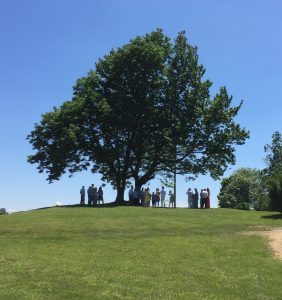
The knowledge of woody landscape plants is essential for anyone in the realm of landscape horticulture. Woody plants can be found in polished urban settings and in relatively untouched natural areas. With knowledge of these plants, you will be able to properly design and manage landscapes, as well as to diagnose and solve landscape plant-related problems.
The information presented in this chapter is designed to prepare you for most tasks and issues that you will encounter in dealing with the use of woody plants. Knowledge of fundamental plant aspects such as hardiness and plant biology are key to using and managing woody plants in a landscape.
This chapter will not delve into the identification of woody plants. However, knowing how to identify at least the most commonly used woody landscape species is a great asset to anyone dealing with these plants. A very scholarly and thorough treatment relative to the identification and use of woody plants is the Manual of Woody Landscape Plants by Michael A. Dirr (6th edition, 2009, Stipes Publishing). This text is an excellent reference and is often considered the “bible” of woody plants.
The goal of this chapter is to provide you with the fundamental woody plant information to understand the basics of woody plant biology relative to landscape applications, and how to appropriately select and manage woody species in the landscape. Some details such as pruning, fertilization, and soil aspects will only be superficially addressed in this chapter since this information is covered in depth in other chapters.
What is a Woody Plant?
Woody plants are perennial (life span ranges from decades to centuries, or in some cases millennia) in which the shoot (above ground portion of the plant) persists during plant dormancy (usually late-autumn to early-spring). For example, an oak tree (Quercus spp.) has a trunk that persists for 12 months, year after year. In contrast, the shoot system of an herbaceous perennial, such as a hosta (Hosta spp.), dies to the ground each fall but the root system persists year after year. Because the shoot system of an herbaceous perennial dies at the end of each growing season, no yearly increase in stem/trunk diameter occurs as it does in woody plants. Woody plants are described as trees, shrubs, groundcovers, and vines. Technically, wood is composed of xylem tissue, mostly dead lignified vascular cells that transport water from the roots to the trunk, stems, leaves, flowers, and fruit. Wood also serves as the structural support system for plant parts.
As with most issues, there are shades of gray. For example, nandina (also called heavenly bamboo; Nandina domestica) is a shrub. However, in the northern part of its adaptable range (USDA Plant Hardiness Zone 6), the shoot system can be killed by low winter temperatures. However, this species will usually produce a new set of shoots (top portion of a plant) the following spring from the root system. Thus, nandina, while typically considered a woody plant, in some years and locations can grow as an herbaceous perennial due to weather-related conditions. We will cover plant hardiness in detail in a future section.
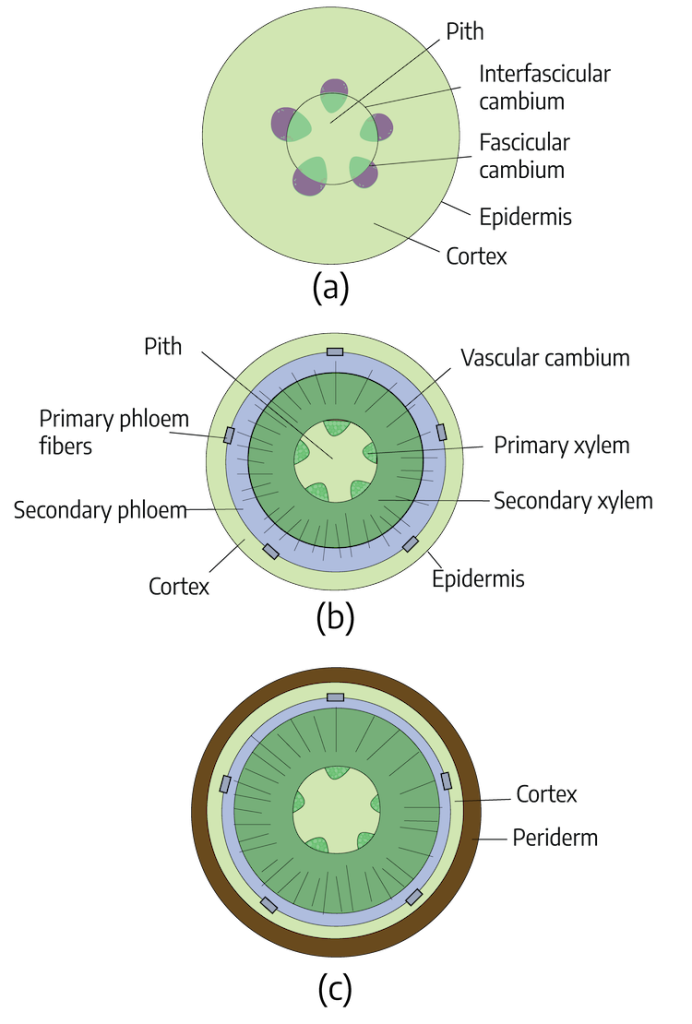
Woody Plant Botany
In many plants, growth in a given tissue ceases when mature. In woody plants, roots and stems continue to increase in diameter in regions that are no longer elongating, thus increasing the girth of the plant. This increase in girth is called secondary growth.
At the start of each growing season, woody plants resume primary growth, adding additional secondary tissues through growth of two lateral meristems: the vascular cambium and the cork cambium.
The vascular cambium is the main growing tissue of stems and roots in most plants. It produces the secondary xylem and secondary phloem. In temperate regions, the vascular cambium is dormant during winter and is reactivated in the spring when the plant’s buds begin to expand and resume growth. During reactivation, the cambial cells take up water, expand, and begin to divide. New growth layers, or increments, of secondary xylem and secondary phloem are laid down during the growing season.
The cork cambium falls outside the vascular cambium and is responsible for growth that replaces the epidermis in stems and roots. It is a layer of bark. Bark is a nontechnical term that refers to all the tissues outside the vascular cambium, including the periderm.
Gymnosperms, woody magnoliids (woody flowering plants that are neither monocots or dicots), and woody dicots undergo secondary growth and are called “woody plants.” Herbaceous plants are plants with shoots that undergo little or no secondary growth (Evert and Eichhorn, 2012).
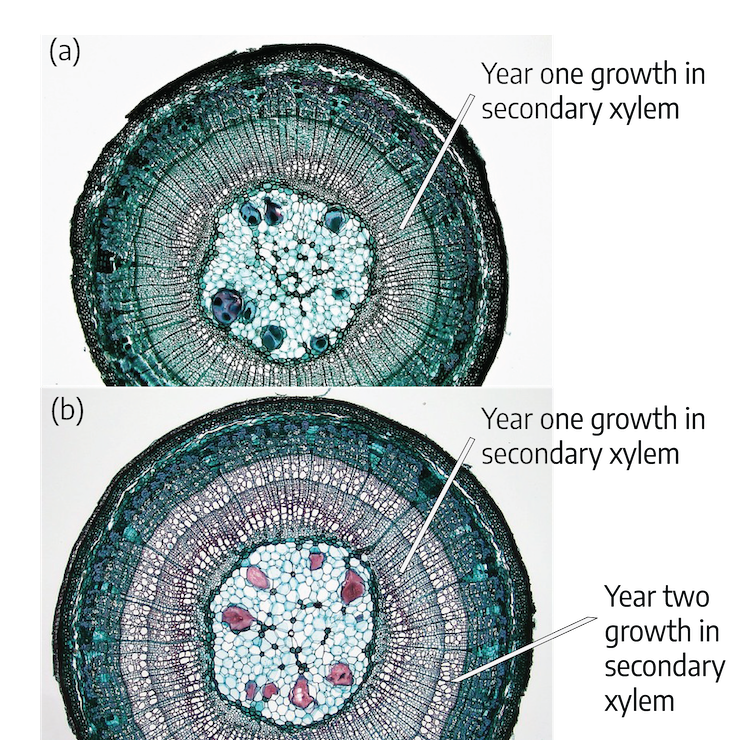
Woody plants can be categorized in several different ways. Three categories, organized by growth habit and foliage type, are;
- Deciduous trees, shrubs, groundcovers, and vines (angiosperms that lose their leaves in the fall)
- Broadleaf evergreen trees, shrubs, groundcovers, and vines (angiosperm species that retain foliage throughout the year)
- Conifers (gymnosperms, mostly evergreen but there are notable deciduous species, that have needle, scale-like, or awl-like foliage)
Note: angiosperm species have true flowers. Gymnosperms bear naked seeds in cones and modified cones.
Plant Sex
Woody species can be categorized relative to the sex of flowers they produce. If a species produces plants with both male and female flower parts on them (either both sexes in a single flower or separate male and female flowers on the same plant), then that species is termed monoecious (literal translation: “one house”). The majority of woody species are monoecious. If a species produces plants with either only male or only female flowers, then that species is termed dioecious (literal translation: “two houses”). Dioecious species require both male and female plants in close proximity to produce fruit/seed. Ilex verticillata (winterberry), a dioecious species, is a popular woody landscape species due to its abundance of showy fruit, and a male plant must be nearby to fertilize (pollinate) female plants for fruit production. If one has a dioecious plant and it has not set fruit, then it may be a male (fruitless by design), or it may be a female with no male in the vicinity. In some cases, a female will produce fruit without sexual fertilization, and this is termed parthenocarpy. There are several popular landscape taxa that are parthenocarpic such as Ilex בNellie R. Stevens’ and Ilex cornuta ‘Burfordii’.
Woody Plant Sizes and Growth Habits
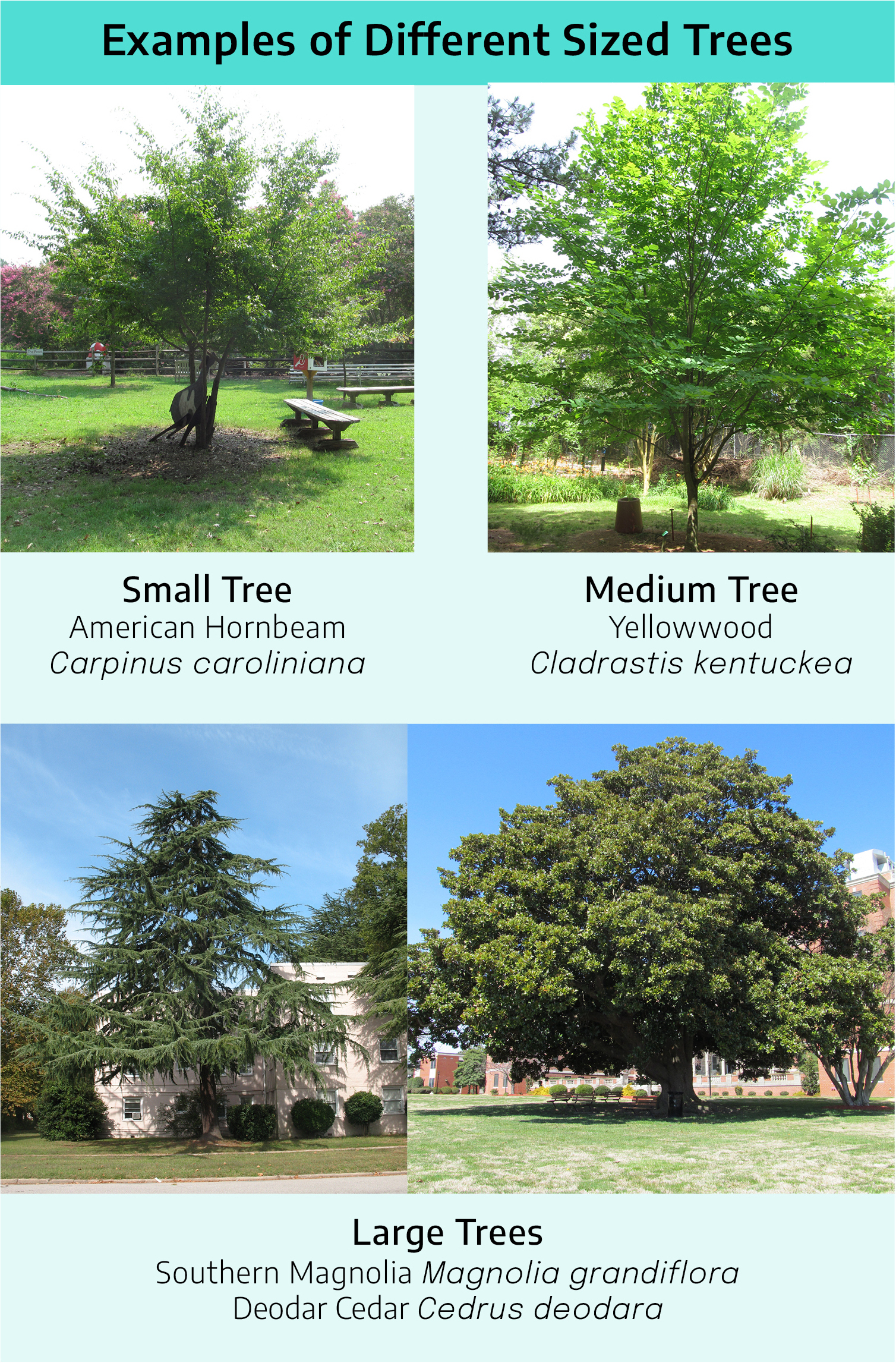
Woody plants are characterized by their height and growth habits. Size characterizations are somewhat arbitrary designations, however, they are useful categories for landscape design and plant selection.
Trees have single or multiple trunks (usually three or less). Mature trees sizes are:
- Small trees: 15-25 feet tall
- Medium trees: 25-50 feet tall
- Large trees: 50 feet tall
From a functional perspective, small trees can be distinguished from medium and large trees. Medium and large trees are generally not differentiated in landscape use since they are both used in areas that require larger scales or in larger areas. Small trees can be used in relatively small areas or anywhere the scale of the surroundings requires or can accommodate a tree less than 25 feet tall (e.g., courtyard and small residential landscape property). A careful determination of the available volume of space and proximity to other landscape or residential features will dictate the appropriate tree size for an area.
Shrubs typically have multiple trunks (usually more than three). Mature shrub sizes are:
- Small shrubs ≤ 5 feet tall – also considered as a groundcover when less than 3 feet tall
- Medium shrubs > 5-9 feet tall
- Large shrubs > 9 feet tall
As with tree sizes, shrub size should be used to match the existing volume of landscape space to be occupied by plants.
The distinction between a small tree and a large shrub is somewhat arbitrary. Many species, such as cornelian cherry dogwood (Cornus mas) for example, can be considered a large shrub or a small tree depending on how it is pruned. An unpruned multi-stem cornelian cherry dogwood is shrub-like, however, if one removes the lower branches and some of the multiple trunks, it will look like a small tree. Thus, plant size and category classifications are open to interpretation and affected by pruning.
Groundcovers generally have a horizontal growth habit and are less than 3 feet tall.
Vines, due to their relatively supple young stems, are shrubs that are unable to sustain an upright habit unless they grow on an upright structure. Many vine species can grow as tall as the structure they cling to. In the absence of a structure, a vine will grow on the ground in a prostrate or mound fashion.
Vines have three modes of attachment. They adhere to a structure by:
- Twining (stems wind around a structure or matrix, e.g. Japanese wisteria Wisteria floribunda)
- Rootlets (stems have adventitious roots that attach to a structure, e.g. English ivy Hedera helix)
- Tendrils (modified stems leaves, or petioles that attach to a structure by twining or holdfasts, e.g. Virginia creeper Parthenocissus quinquefolia).
Vines with rootlets and tendrils (with holdfasts) can grow up a wall (or other vertical surface) since rootlets and tendrils adhere firmly to a surface. Vines that twine will not grow on a wall unless there is a lattice or some other matrix for it to cling to. All vine types can grow up trees regardless of climbing mode.
Factors affecting plant size
Plant size is affected by a plant’s genetics and the environment. In terms of the environment, available resources such as water, light, and nutrients, as well as site-related conditions (e.g., soil, climate, competition, pest pressure, and human impacts) greatly influence plant growth. Also remember that within a population of any plant species, there will be a great amount of variability in plant characteristics such as height, width, leaf size, and flower, and fruit characteristics due to genetics. In terms of mature height, one may find individuals that are much taller or shorter than the average individual. Thus, ascribing a plant size, e.g., small tree or medium tree, to particular species is less than precise. For example, American hornbeam (Carpinus caroliniana) is generally categorized as a small tree with a mature height of 20-30 feet tall. Our definition of a small tree is 15-25 feet tall, so one can see that occasionally this species can be classified as a medium tree. There are American hornbeams that are 65 feet tall; by definition such a tree would fall into the large tree category. Such atypical plants may be growing in an ideal site and/or may have the genetic capacity for taller than average height.
Plant size and landscape use
Woody plant size is a very important aspect because one of the most common landscape design/plant installation mistakes is to design/install a species that will grow outside its intended volume of space. Pruning, while a necessary component of tree care, is a generally an ineffective remedy for this mistake (since size-limiting pruning will need to be continually repeated); additionally, it is also time consuming, costly, and creates plant debris which then creates debris disposal issues. In some cases, pruning is not a viable option since the required pruning will significantly distort the tree/shrub form. Trees placed too close to a structure can pose a significant liability when they mature, since limbs/trunks have the potential to fall and damage a structure during snow, ice, or wind storms. Tree pruning/removal is very expensive; so, one must be very careful in designing/placing trees next to structures.
Species Diversity and Monoculture
Species diversity is the use of many varied taxa (family, genus, species) within an “area”, where an area may range from a residential site to municipal or larger sites. Species diversity implies that a landscape (garden size to much larger areas) is composed of a mix of species from a wide range of genera and plant families. Species diversity guards against a disproportionate loss of landscape plants in the event of an insult such as a pest attack (e.g., insect, mite, fungus, or virus) or some damaging environmental event (e.g., drought; excessive rain, wind, or snow; ice storm; or atypically high/low temperatures).
The overuse of any plant taxa (i.e., cultivar, species, genus, or family) in a landscape is regarded as a monoculture. There are no research-based values (number and type of taxa per unit land) for determining a monoculture, and “overuse” is a matter of degree. A classic example of monoculture was the American elm (Ulmus americana). By the 1930s there were tens of millions of American elm trees planted in North America. The American elm was widely planted as a street tree since it was fast growing, tolerated urban conditions, and had a beautiful vase shape. In 1930, Dutch elm disease, a fungus spread by a beetle, was introduced into the U.S. The disease has killed most of the native and planted American elms and only a very small fraction of American elms have survived this disease. While there are no scientifically determined values for the relative number of plant taxa in a landscape to have a diversified landscape, a landscape should have a sufficient number of plant species in several plant families and genera to ensure genetic diversity. Tree inventories are especially helpful to determine the family and species composition of a landscape/area.
Hardiness
Hardiness refers to a plant’s ability to withstand low winter temperatures and remain aesthetically pleasing. Plant hardiness is an especially important concept to understand because lack of this understanding can result in some very costly plant use mistakes.
USDA Plant Hardiness Zone Map
The USDA Plant Hardiness zone map divides the country into different 10-degree F zones based on average annual minimum winter temperature. Zone 1a is the coldest and zone 13b is the warmest, with Virginia ranging from 8a to 5a. Zones in the current map (2012 version) are based on 1976–2005 weather data and are calculated by averaging the lowest daily winter temperatures for a given location during this time period. Zones do not represent the coldest it will ever be in an area.
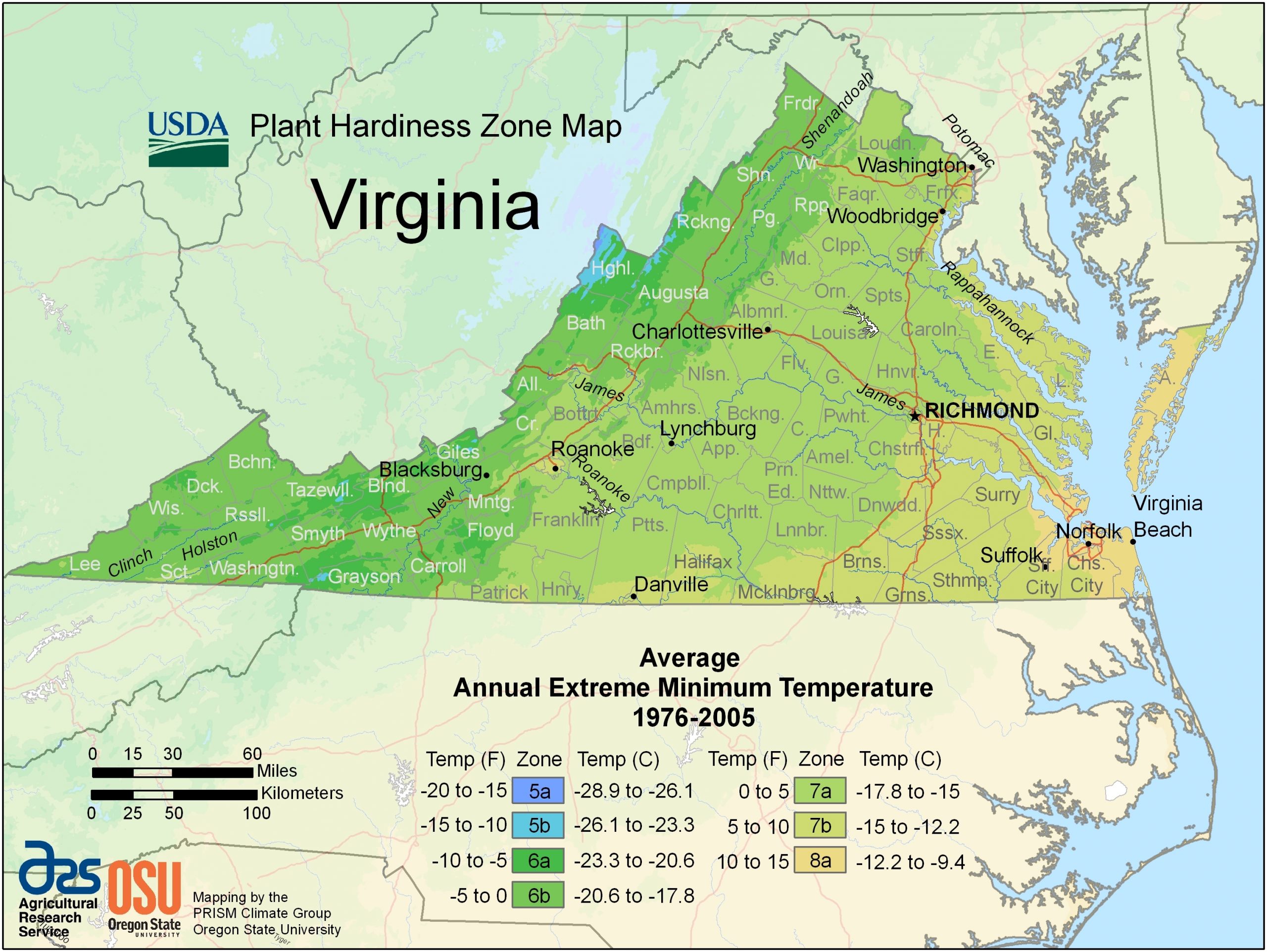
Each woody landscape species has a designated hardiness rating. These ratings may vary depending on the source of the plant information. Redbud (Cercis canadensis) has a plant hardiness rating of zone 4 to 9 (often designated by 4 – 9). The first part of this rating (the number 4) refers to the lowest temperatures this species can tolerate (zone 4; -20 to -30° F). The second part (the number 9) refers to the highest temperatures that this species can tolerate. Thus, one can successfully grow redbuds from zone 4 through 9. The hardiness rating of Fraser fir (Abies fraseri) is 4 to 7, and will perform poorly in zone 8 (and even in zone 7b) due to this fir’s lack of heat tolerance (and other heat-related aspects).
Of course, the USDA Hardiness Plant Zone designations are a guide and not an exact tool to rate plant temperature response since plant hardiness is a complicated phenomenon. Factors that are involved with the hardiness of a particular species are the prevailing weather conditions for a particular year, and how well established a plant is (penetration of roots from root ball into surrounding soil). Plants that are not well established will be much less hardy then an established plant. In terms of weather, the minimum temperatures and how long these temperatures persist, and how the onset of cold weather proceeds can affect a species’ tolerance to low temperatures. In some years, woody species have been damaged when there is a mild fall that is followed by uncharacteristically low temperatures. In this case, the plants did not gradually acclimate to low temperatures, and did not achieve the necessary degree of hardiness. Late spring frosts are also damaging to some species, so in addition to the minimum temperature, the manner in which low temperatures prevail has a major influence on plant hardiness. Soil moisture conditions will also affect winter hardiness. In a relatively dry fall and winter, foliage of evergreens (conifers and broadleaved) will experience significant leaf damage. Excessive soil moisture can also negatively impact plant hardiness. Again, plant hardiness is not only related to low temperatures, but is the result of interacting factors.
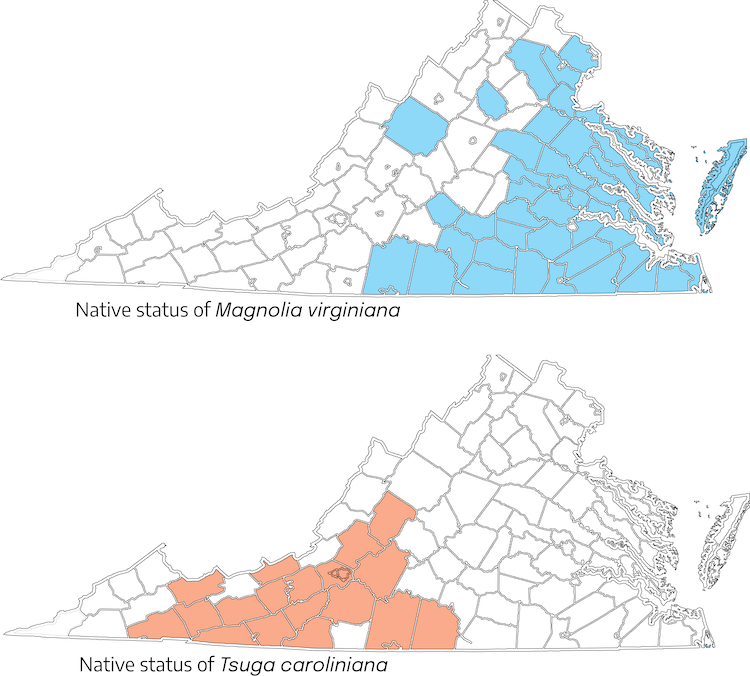
Provenance
We already noted that the hardiness range of redbud (Cercis canadensis) is zone 4-9. In terms of a natural population, we can expect that redbuds, and most other woody plants, in the most northern parts of its population will have the genes to tolerate zone 4 winters (-20 to -30° F). Redbuds, and most other woody species, from the southern portion of its hardiness range will have genes to tolerate the relatively high summer heat of the southern U.S. Seed collected from the southern part of the redbud population may not have the genes to tolerate the minimum winter temperatures in zone 4. Conversely, plants from zone 4 will most likely not have the genes to tolerate the heat of zone 9. Thus, when procuring plant material, the source of the plant material may be an important consideration. The term to describe the geographical source of plants (and other entities) is called provenance.
The Virginia Department of Forestry (DOF) grows seedlings sourced from Virginia trees and shrubs, which can be ordered seasonally through the DOF Buy Virginia Trees website.
A plant native to one part of Virginia may not be native to other parts of the commonwealth. For example, Sweet Bay Magnolia (Magnolia virginiana) is native to the eastern parts of Virginia, but not the western parts. On the other hand, Carolina hemlock (Tsuga caroliniana) is native only to the western-central part of the commonwealth. To look up whether a particular species is native to your county, use the Digital Atlas of the Virginia Flora.
Historic Lows
Remember that the USDA Plant Hardiness Zone Map is based on average annual minimum temperatures and were calculated by averaging minimum annual temperature collected over the 29 years that data were recorded. Since the low temperature for any one zone is an average, the possibility exists that the low temperature for any one winter may be lower than the zone indicates.
For example, Blacksburg, Virginia is in zone 6b; the USDA Plant Hardiness Zone Map notes that the average minimum temperature range for zone 6b is 0 to -5° F. In fact, the record low for Blacksburg is -18° F (January, 1985). Several zone 6b woody species (and most zone 7a plants planted on a gamble) were killed in January 1985. Thus, knowledge of the historical low temperatures for a particular area you are landscaping is important to ensure that woody species are selected to survive the extreme low temperatures. This is especially important if you are planting numerous individuals of one species. Keep in mind that the use of hardiness zone ratings is a guide and not an exact science.
Hardiness of Plant Parts
Not all plant parts are equally hardy. The root system is the least hardy portion of the entire woody plant. Since roots are insulated by the soil (winter root zone soil temperatures are generally warmer than ambient air temperatures), root zone temperatures are usually not a consideration for landscape plants. However, if one is overwintering container-grown woody plants without protection, as in the case of a roof-top garden, then low temperatures and root hardiness should be taken into consideration.
The temperature that roots will tolerate is species specific. For example, roots of flowering dogwood (Cornus florida) are killed at 20° F, whereas roots of white spruce (Picea glauca) are killed at -10° F. There is a rule of thumb for unprotected container-grown plants that prescribes that one must select a species with a hardiness zone rating that is two zones lower than the zone you are in for the roots to tolerate the low winter temperatures. Thus, one should select a zone 4 species to survive as a container-grown plant in zone 6. Nursery growers in many parts of Virginia overwinter container-grown plants by covering plants in plastic blankets or in plastic-covered hoop houses; such coverings trap ground heat and maintain root zone temperatures above the ambient outside temperatures. There are websites that list root killing temperatures for many woody plant species.
The above ground portion of a woody plant, the shoot system (leaves and stems), gradually acclimates to lower temperatures in the fall with the onset of low temperatures and progressively short periods of daylight. Parts of the shoot system vary in their low temperature tolerance. Woody plant flower buds are usually less winter hardy than vegetative buds (produce leaves and stems) and stems. Thus, low winter temperatures may injure or kill flower buds, but not affect vegetative bud and stems. A classic example of this phenomenon occurs in bigleaf hydrangea (Hydrangea macrophylla). Listed as a zone 6 to 9 species, bigleaf hydrangea flower production in zone 6 is commonly less than in zone 7 because typical zone 6 winter temperatures kill the flowers buds which were produced in the summer prior to the year they flower. Unless the minimum winter temperatures are relatively high in zone 6, very few if any bigleaf hydrangea flower buds will survive the winter; even stems are commonly killed in typical zone 6 winters. In response to this zone 6 flowering problem with bigleaf hydrangea, cultivars of Hydrangea macrophylla have been selected that flower on new wood (to be discussed) and will flower in the summer even after a low temperature winter.
Microclimate
In any county, city, neighborhood, or area around a house/structure there may be areas that have minimum and maximum temperatures that are atypical for that area’s designated hardiness zone. Slope, altitude, compass orientation, proximity to water or a building, the amount of pavement and buildings, overhead canopies such as trees and arbors are some of the aspects that will influence temperature. Zones of atypical high or low temperatures are called microclimates. Knowledge of these microclimates will influence how you choose species according to hardiness zones for these areas. For example, since cold air is heavier than warm air, cold air moves down a slope, and air at the bottom of the slope would be colder than the temperature of air at top of the slope. Knowing microclimates that are warmer than your zone (such as a protected location on the south side of a house or under an arbor), will allow you to successfully grow a species that is not typically hardy in your zone.
Growth Rate
Woody Plant Growth Rate Categories
Woody plants are categorized into three growth rate categories. These are:
- Slow: less than or equal to 12 inches per year
- Moderate: 13-24 inches per year
- Fast: greater than or equal to 25 inches per year
Woody plant growth rate is an aspect that impacts: 1) maintenance, 2) placement/spacing of plants, and 3) how slowly or quickly a plant will fill its intended space in the landscape. Most species have a moderate growth. A fast-growth rate can be an asset if one is planting a row of small plants for a privacy hedge, or can be a liability if one has to prune to control plant size or density. As noted for plant size, growth rate is not only dictated by plant genetics, but also by available resources such as water, light, and nutrients, as well as site-related conditions (e.g., soil, climate, competition, pest pressure, and human impacts).
Conifer Growth Rates
Conifers are best described by their growth rate and NOT by a mature size since mature size designations are generally not accurate. The American Conifer Society database has published the following categories, growth rates, and approximate size (height and/or width) of conifers.
Table 13-1: Conifer growth rates
| Category | Growth per year (inches) | Approximate size at 10 years (feet) |
|---|---|---|
| Miniature | <1 | <1 |
| Dwarf | 1-6 | 1-6 |
| Intermediate | 6-12 | 6-15 |
| Large | >12 | >15 |
A dwarf conifer, usually a cultivar of a conifer species, has a slower growth rate than the species. Dwarf conifers are valuable components of a woody plant palette since they offer numerous options of using plants with a variety of sizes, forms, textures, and colors in space-restricted landscapes.
Functions of Woody Plants
Woody plants serve aesthetic, architectural, and environmental functions. They also serve specific landscape-related functions.
Aesthetic Functions
Woody plants can have attractive foliage, flowers, fruits, bark, and/or form throughout the year. Because woody plant shoots (stems/trunks) persist in the dormant season, in contrast to most herbaceous plants, characteristics such as branch/trunk structure (form/habit), bark, fruit, and foliage in the case of evergreens (broadleaf and conifers) serve to beautify the landscape when plants are dormant.
The visual characteristics of plants, size, form, color, and texture, are like paints on an artist’s palette. Thus, as an artist selects different colored paints to compose a picture, one who selects woody species for a landscape design does so by choosing plant sizes, forms, colors, and textures as manifested by trunk/ branch configuration, bark, foliage, flowers, and fruit characteristics. There are limitless combinations of size, form, color, and textures that will make a landscape attractive for 365 days a year. Because plants are ever-changing throughout seasons and years, the landscape “picture” is dynamic as well.
Plant size and form has a very large impact on where a plant can be grown and how it is used in the landscape. Plant size, as previously discussed, will impact where a species can be placed in the landscape. Large trees, by virtue of their mass, are visually dominant structures in the landscape. Most trees and shrubs have an oval or round form. Some trees can have a weeping or pendulous form (branches hang down), a fastigiate form (narrow oval), or a columnar form (column-like). Some deciduous trees and many conifers (especially in their youth) have a conical or pyramidal form. Tree form also influences how one perceives the landscape. In general, round and oval forms have a neutral effect on the eye; conical, fastigiate, and columnar forms bring the eye skyward; pendulous forms bring the eye to the ground plane.
Other sensory aspects are involved in woody plant selection such as smell (flowers), taste (fruit), and movement (leaves fluttering, flower petals falling).
Architectural Functions
Woody plants serve important architectural functions in the landscape. Woody plants give a landscape structure, and are likened to the backbone of landscape. Trees, shrubs, and groundcovers serve as the ceilings, walls, and floors of outdoor spaces. They also serve to frame views and create outdoor rooms. In addition, woody plants can be pruned and trained to create structures such as walls, doorways, and architectural focal points such as topiaries.
Environmental Functions
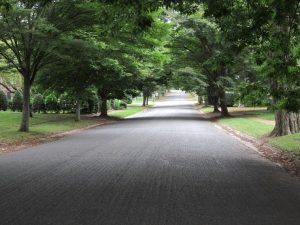
Woody plants have numerous significant effects on the landscape environment. While expounding on these effects is not the focus of this chapter, there are a few noted effects that you should know. The shade of deciduous trees that are mainly placed on the southeast and southwest side of a structure can cool structures in hot months. Trees for shade are generally not placed directly on the south side of a house since the sun is at a very high position in the sky at midday, the time at which the sun is due south of a structure. The sun’s high position means that a shade tree would have to be very close to a structure to provide shade, and this close placement would be a potential hazard in the event the tree fell on the house. Evergreen trees/shrubs placed on the northwest side of a structure can prevent heat loss from a structure in cold months by acting as a wind break.
Woody plants also reduce noise, pollution, runoff, and soil erosion. Trees reduce air pollution by trapping particulate matter in their leafy canopies and by absorbing noxious pollution into their leaves. The particulate matter is eventually washed away with rain. Absorbed pollutants are incorporated into the soil after leaf fall where they are broken down by microbes. These actions reduce human health problems related to air pollution. Tree canopies also intercept large amounts of rain, reducing the amount of runoff that is discharged into streams and rivers and extending the time that a watershed has to absorb rainfall. This reduces flooding and erosion.
As trees grow they accumulate biomass that absorbs carbon and nutrients, locking them into a biological cycle that keeps them out of the atmosphere and hydrosphere. The storage of carbon reduces the greenhouse effect that is linked to problems of global climate change. Absorbed nutrients stay out of water bodies where they would otherwise harm fish and other aquatic species.
In summer, trees ameliorate climate by transpiring water from their leaves, which has a cooling effect on the atmosphere. At night, when the earth radiates heat back into space, temperatures often drop to the cooling or dew point, when water vapor, some of which is produced by trees during the daytime, condenses. This releases latent heat back into the atmosphere. When groups of trees intercept sunlight and use it for photosynthesis, they shade roads, buildings, and other structures, and they help reduce energy consumption.
Woody plants serve as wildlife habitats, and can produce food for households (e.g., blueberries, apples, and figs). Of course, trees and shrubs have a marked social effect on humans as noted by their presence and effects in parks, botanical gardens, cemeteries, urban green spaces, and natural areas. Benefits to society are harder to quantify, but that does not mean they are less important than the ecological services that trees provide. Societal benefits include increased job satisfaction, faster recovery time for hospital patients, and improved child development (see VCE publication “Value, Benefits, and Costs of Urban Trees” 420-181).
To calculate individual tree benefit estimates or view tree canopy estimates for your area, go the U.S Forest Service’s iTree calculator website.
Specific Landscape Uses of Plants
In addition to the previously mentioned architectural and environmental functions, plants are used in the landscape for numerous functions related to various landscape design reasons. These uses are overlapping and are not exclusive to each other. For example, a hedge can function as a border and a barrier. These are the main specific landscape uses of plants:
- Accent plant(s): a plant or plants that are used to add emphasis, draw attention to, or compliment another plant, structure, art work, or any other landscape feature.
- Barrier: a row (linear or curvilinear) of plants that separates one area from another and impedes movement (e.g., human, pets)
- Border: a row (linear or curvilinear) of plants that separates one area from another
- Foundation plant(s): Use of species or more than one species (usually evergreen) to 1) hide the view of an undesirable sight such as the foundation of a house, or 2) give a structure or landscape element a “base” to avoid the stark transition of the ground with the structure.
- Hedge: a living fence to separate areas either for barrier or border functions
- Massing/Grouping: use of many plants, usually of a single or two species, to 1) collectively emphasize the features of the species (e.g., form flowers, fall foliage color), 2) to give a natural appearance, 3) create a border or barrier
- Screen: plants used to screen a view/object or to provide privacy.
- Specimen plant: a plant that is featured by itself (or with smaller plants around it) to act as a focal point in the landscape. A specimen plant has sufficiently notable characteristics (e.g., size, form, color, and texture via trunks/stems, foliage, flowers, and fruit) that warrant its use as a focal point. A plant may be a focal plant 12 months a year, such as a Japanese maple in a courtyard, or for part of a year such as in the case of a conifer amongst deciduous plants; the conifer will be most evident and have a strong visual impact in winter months when deciduous trees are leafless.
Choice of Nursery Stock
Most woody plants purchased at garden centers are sold either as container-grown plants or as balled-and-burlapped, commonly called B&B, plants.
The Virginia Department of Forestry (DOF) grows seedlings for Virginia landowners, which can be ordered seasonally through the DOF Buy Virginia Trees website. These seedlings are suited for Virginia soils and climate.
Container-Grown Plants
Most shrubs, groundcovers, vines, and young trees are produced and sold in plastic containers with a pine bark-based potting soil. The advantages of container-grown plants are:
- Have 100% of an intact root system
- Convenient to transport
- Relatively light weight
There are two disadvantages of container-grown plants:
- The pine bark potting soil only holds about a one to two day water supply for the plant
- Plants can become root bound
Relative to the water reservoir capacity of the pine bark, a container-grown plant must be watered daily or every other day (depending on plant water use and weather conditions) during the growing season (or until the root system has grown into the surrounding soil and can support itself without supplemental irrigation). A way to avoid this frequent irrigation of container-grown plants is to plant them in the fall when plant water needs are greatly reduced. Of course, most landscape plants, newly planted or established, will need some degree of irrigation during drought periods.
If a container-grown plant has become root bound (solid mass of circling roots on the perimeter of the root ball), then the plant has stayed in that container too long. This is an undesirable situation since roots of most species cannot escape this circular entanglement. In some cases, roots can be pried, teased, or cut from the root ball to encourage growth into the surrounding soil.
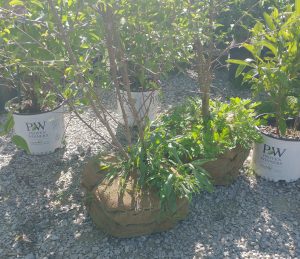
Balled-and-Burlapped Plants
Balled-and-burlapped plants are grown in the field. They are then machine-dug and lifted out of the soil. The somewhat round root ball is then covered with burlap (and sometimes with a wire cage) to keep the root ball intact. While some balled-and-burlapped plants are sold in retail garden centers, most of these plants are used in the landscape contracting trade and are planted by landscape contracting company personnel.
Advantages of balled-and-burlapped plants are:
- A less intense production system compared to container-grown plants
- Root system is surrounded by mineral soil that retains water for long periods and when planted requires irrigation only about once a week
- Relatively large trees are available via the balled-and-burlapped system
Disadvantages of a balled-and-burlapped plant are:
- Approximately 80+ % of the root system is removed
- Plants take three years to recover from root severance
- Root balls are very heavy; transporting and planting are relatively labor intensive compared to transporting and planting container-grown plants
Regardless of woody plant growing/harvesting system (container versus balled-and-burlapped), adequate irrigation of recently transplanted plants is extremely important for plant survival. In both systems, one should apply enough water to wet the root ball and very little of the surrounding soil; most mineral soils are very moisture retentive. Applying excessive irrigation (an amount to wet root ball and surrounding soil) can keep the soil around the root ball too wet and this can discourage root growth into the soil; this is especially true for soils with a relatively high clay content.
Bare Root Plants
Bare root plants are perennials that are dug up and sold without soil around the roots, during their dormant season. They are often small and young. Many plants purchased online are shipped bare root because the lack of soil makes them lighter and easier to ship. Strawberries, asparagus, fruit trees, and ornamental trees/shrubs are all commonly sold as bare root plants.
Once in your care, bare root plants should not be allowed to dry out. If you do not plant them immediately, they should be stored in a cool location but kept away from extreme cold. Cut off any dead roots and branches before planting. Most bare root plants should be soaked in water before planting. Your plant should come with instructions for soaking and planting. Spread remaining roots out evenly in the hole and gently pack soil around them. Bare root trees may need to be staked the first year.
After planting, bare root plants will begin to grow again. You should see shoots or other signs of growth relatively quickly after planting. A bare root plant that does not grow the first year is dead.
Right Plant for the Right Place and Right Function
One of the biggest challenges dealing with woody plants is to determine the appropriate species for a landscape. The inappropriate selection of woody plants has major consequences such as:
- Increased cost, time, and effort in woody plant maintenance
- Potential hazards from trees/tree parts falling on people, property, and structures
- Potential hazards from species with thorns or poisonous plant parts
- Incurring major costs of removing trees that pose hazards, are prone to storm or pest damage, or are not suited to the landscape
Steps to Select the Right Plant for the Right Place and Function
There are four steps to choose the right plant for the right place. Following these steps will help you create a beautiful, functional, and environmentally sound landscape.
1. What are the functions and themes of the areas of your landscape?
For example, lawn for recreation, shady area with arbor for relaxation, sunny area for vegetable garden, beds next to a house for foundation plants, and beds near property border for privacy planting. These functional aspects will dictate whether trees, shrubs, groundcovers, or vines are needed. You should also consider the theme of your landscape. Is your area to be more natural or more formal? Formal landscapes usually have a linear and/or modular design and utilize species with a distinct symmetry (or are pruned to be symmetrical). Conversely, natural landscapes tend to have curvilinear design and utilize species that are less symmetrical.
One must take into consideration the mature size of trees for four reasons. 1) Trees will ultimately occupy a much larger volume than the initial planting and thus may grow into areas occupied by other plants or structures. 2) Trees will cast a considerable amount of shade to the south, southeast, and southwest, which may impact plants that require a full or near full sun exposure such as lawns and conifers. 3) As trees grow the amount of leaf and other plant part litter (e.g., pollen, flowers, fruit, and stems) greatly increases, hence maintenance greatly increases as well. 4) Tree roots can extend a considerable distance beyond the edge of the tree’s canopy and can invade nearby septic or drainage systems. Tree roots will also very effectively compete with other plants for soil water and can render a soil quite dry. Once each area of the landscape has a designated function then proceed to the next step.
2. What are the functions of the woody plants to be placed in the functional areas of your landscape?
Determine the specific aesthetic, architectural, environmental, and landscape functions (these topics covered earlier in the chapter) of the trees, shrubs, groundcovers, and vines to be placed in each area and proceed to the next step.
3. What are the existing environmental conditions?
Important aspects to determine are:
-
- Soil texture, pH, and nutrient content
- Soil moisture aspects/slopes and low areas
- Sun and shade areas
- Wind paths
- USDA Plant Hardiness Zone
- Prevalence of deer and other vegetation-destroying animals
- Existing plant species
- Access to irrigation
- Existing and future hardscapes, utility conduits and septic systems, warm air vents
Assessing these conditions will allow you to select the species that are suitable for the site to be landscaped.
4. Combine information from steps 1, 2, and 3 to design the landscape and to choose the appropriate trees, shrubs, groundcovers, and vines according to the site conditions.
Woody plants vary greatly in terms of their size, form, texture, and color. They also vary greatly in their growth rate; soil, water, light requirements/tolerances; hardiness/high temperature; pest susceptibility; messiness; and invasiveness. Thus, examination and determination of the step 3 environmental aspects (site conditions) will dictate the species that should be selected for a particular landscape site. Step 2 will dictate the plant category (tree, shrub, groundcover, and vine) choices.
Invasive Plants
According to the Virginia Department of Conservation and Recreation (DCR), invasive plants are “species intentionally or accidentally introduced by human activity into a region in which they did not evolve and cause harm to natural resources, economic activity or humans” (“Invasive Plant Species”). DCR ranks invasive species according to their potential harm, however this list does not have any regulatory authority, so species included on this list may still be sold at nurseries.
Plants deemed “noxious weeds” are subject to regulation. The Virginia Noxious Weeds list is maintained by the Board of Agriculture and Consumer Services (BACS). The Noxious Weed List is available here.
Every four years, an “Invasive Species Management Plan” is prepared by the Invasive Species Advisory Committee. This plan describes the current regulatory landscape of invasive species management in Virginia and offers opportunities for improvement.
See also the VCE publication “Invasive Plants – A Horticultural Perspective” 426-080
Challenge
This chapter has covered the different types and functions of woody plants, but it can only begin a broad learning process. Trees, shrubs and the like form the study backbone of the local flora and support the local fauna; but the species mix will vary wildly from place to place. Simply reading about the glories of oak trees in general does not tell you whether a live oak or chestnut oak is better suited to where you are. The next, really important step is to get to know the woody plants that have the most importance in the local area. Go on guided tree walks, invest in a plant-ID app, or just get up close and observe the woody plants around you through the seasons. Take care to note the interactions with those plants: a short list to start: insects, birds, mammals, other plants, stormwater patters, and people.
Additional Resources
- VCE Master Gardener Tree Steward Manual
- VCE publication “Value, Benefits, and Costs of Urban Trees” 420-181
- U.S Forest Service’s iTree calculator website
- Noxious Weed List
- “Invasive Plants – A Horticultural Perspective” 426-080
Books:
- Dirr, Michael, A. (2009.) Manual of Woody Landscape Plants, 6th edition. Stipes Publishing.
References
“Invasive Plant Species of Virginia.” Virginia Department of Conservation and Recreation. https://www.dcr.virginia.gov/natural-heritage/invspinfo
Evert, Ray F. and Eichhorn, Susan E. Raven Biology of Plants. 2012. W. H. Freeman.
Attributions
Prepared by Alex X. Niemiera, Professor, Department of Horticulture (2015)
- Carol King, Hampton Extension Master Gardener (2021 reviewer)
Image Attributions
- Figure 13-1: Plants can grow very large. Johnson, Devon. 2022. CC BY-NC-SA 4.0.
- Figure 13-2: Diagram of secondary growth in woody stem. Johnson, Devon. 2022. CC BY-NC-SA 4.0. Adapted from “Figure 26-6” in Raven Biology of Plants. 2012. by Eichhorn, Susan E., and Evert, Ray F. Originally from W. Troll. 1937. Vergleichende Morphologie der Hoheren Pflanzen, vol. 1, pt. 1, Verlage von Gebrüder Borntraeger, Berlin.
- Figure 13-3: Cross section of woody dicot stem. Johnson, Devon. 2022. CC BY-NC-SA 4.0. Includes “Woody Dicot Stem: Two Year Tilia” and “Woody Dicot Stem: One Year Tilia” Berkshire Community College Bioscience Image Library form Flickr. 2014. Public Domain.
- Figure 13-4: Examples of different sized trees. Carol King. 2022. CC BY-NC-SA 4.0.
- Figure 13-5: USDA plant hardiness zone map. USDA. 2012. Public domain. https://planthardiness.ars.usda.gov/.
- Figure 13-6: Comparison of native range of two different Virginia species. Johnson, Devon. 2022. CC BY-NC-SA 4.0. Includes “Map of Virginia Counties and Independent Cities.svg” by Dbenbenn. 2009. Wikimedia. CC BY-SA 3.0. Data from Digital Atlas of the Virginia Flora.
- Figure 13-7: Japanese Elms, Zelkova serrata shading a city street in Richmond. Carol King. 2022. CC BY-NC-SA 4.0.
- Figure 13-8: Balled-and-burlapped plants (center) surrounded by container grown plants. Johnson, Devon. 2022. CC BY-NC-SA 4.0.
Perennials (life span ranges from decades to centuries, or in some cases millennia) in which the shoot (above ground portion of the plant) persists during plant dormancy (usually late-autumn to early-spring)
Growth in lateral meristems that causes increase in girth
The main growing tissue of stems and roots in most plants. It produces the secondary xylem and secondary phloem.
Falls outside the vascular cambium and is responsible for growth that replaces the epidermis in stems and roots.
A nontechnical term that refers to all the tissues outside the vascular cambium, including the periderm
Angiosperm trees that lose their leaves in the fall
Flowering plants that produce seeds enclosed in a fruit
Angiosperms trees that retain foliage throughout the year
Gymnosperms, mostly evergreen but there are notable deciduous species, that have needle, scale-like, or awl-like foliage
Seed-bearing vascular plants that produce exposed seeds, or ovules, which are usually borne in cones
Plants with male and female reproductive organs on the same plant
Plants with male and female reproductive organs on separate individuals
Stalk that supports the leaf blade
The use of many varied taxa (family, genus, species) within an “area”, where an area may range from a residential site to municipal or larger sites
A plant’s ability to withstand low winter temperatures and remain aesthetically pleasing
Source of plant material
Zones of atypical high or low temperatures
Tree form in which branches hang down, also called weeping
Tree form that looks like a narrow oval
Column-like tree form
Perennials that are dug up during their dormant season and sold without soil around the roots

